Manage Property Listings Right from your CRM
AscendixRE is CRM for CRE agents that in addition to CRM functionality has a property listing platform solution. Request a demo.
The good old CRM vs Excel battle still sparks discussion, and while businesses confidently trade spreadsheets for automated workflows, some of them still cling to formulae and color coding.
Should we all switch to CRM or adhere to the familiar? Well, Excel can still be a good match for a few cases in the short run. But if you, like us, prioritize business growth, look ahead to investing into innovation that CRM brings – and it’s not only about robust third-party integration or high customization. Now let’s dive deeper into the problem.
CRM is a digital solution, primarily used for client relationship management (hence ‘CRM’), but also for lead generation, secure data storage, sales and marketing management, and smart reporting. Some CRMs are packed with built-in data analytics features and offer wider third-party integration compared to other standard solutions alike.
Unlike CRM, Excel is a Microsoft spreadsheet program used for data entry and its organization in tables as well as data analysis and calculations provided by basic formulae.
In comparison to CRM, Excel doesn’t offer the essential functionality required for large-scale business management and growth, like advanced data analytics, workflow automation, and multiple-user collaboration.
Nevertheless, you can improvise and build an Excel CRM if your business doesn’t require managing large volumes of data. Let’s find out how you can use Excel as a CRM for small-scale businesses.
Startups often have limited resources, therefore aren’t ready to invest in mature digital solutions, especially ones based on upfront payment models. Other than that, most startups have uncomplex sales funnels, fewer lead generation sources, and smaller volumes of customer data. Sure, building a CRM in Excel is a good idea in this case, but once you grow your client base, switching to a full-fledged solution like CRM is important to accelerate your business development.
During the last 2 decades of business automation consulting and custom solution development, we’ve seen cases when brokers looked for owning individual CRMs all due to the highly competitive environment. However, if you’re not looking to invest in CRM yet, you can use Excel to manually enter and organize your client data, calculate and track commissions, and create charts/graphs for data visualization.
These aren’t only startups but also niche or regional businesses for whom a small customer base is a definition of their operations. Such businesses can build an Excel CRM database for bookkeeping and budgeting, inventory management, and contact storage.
A straightforward sales funnel often means a deal starting with lead generation and immediately ending with closing. Some software-as-a-service companies, subscription-based services, and businesses with direct sales models fall into this category. Here, all of them can benefit from Excel as a CRM, since simple sales funnels don’t require multiple automated follow-ups, client communication tracking, or email marketing.
For businesses with not much data to manage, using Excel as a CRM is a cost-effective solution both in terms of usage and the onboarding process, traditionally associated with CRM adoption. Companies with low data volumes can use Excel as a tool for metrics calculations as well as data storage, visualization, and organization.
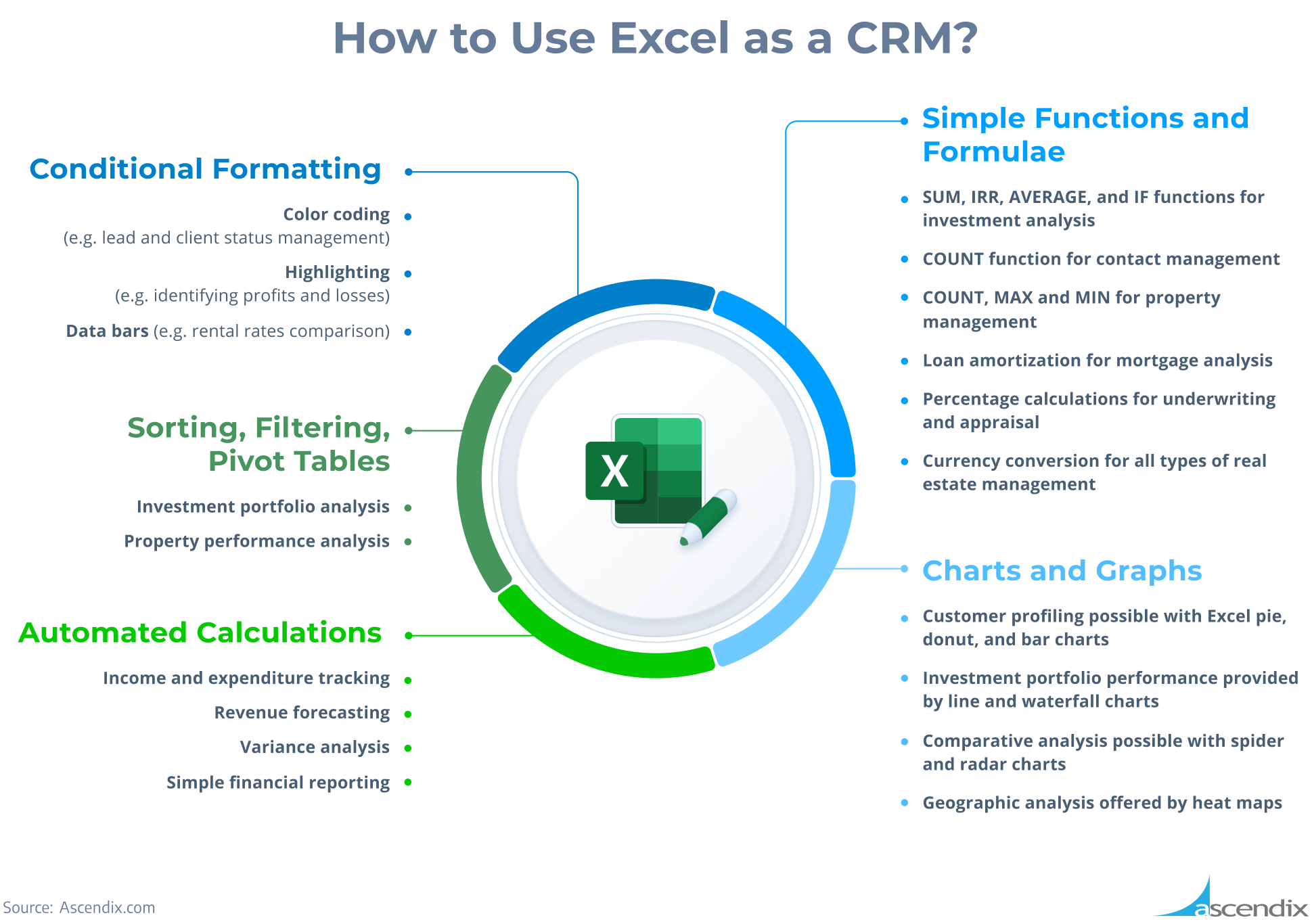
How to Use Excel as a CRM
In Excel, conditional formatting allows users to categorize data and identify patterns in the spreadsheets with the help of rules or specific conditions like color coding and highlighting.
Real estate professionals can use conditional formatting to assign colors to lead and client statuses, identify profits and losses (for instance, Excel can identify exceeding expenses as ‘red’ items and profits as ‘green’), analyze investment portfolio patterns, and segment customers to better understand their behavior.
There are a variety of formulae and functions that real estate professionals can use for budgeting, accounting, and basic data analysis.
Examples of actions that Excel functions and formulae make possible are as follows:
An improvised Excel CRM can help you get more insights into metrics like property performance, lead generation, client retention rates, etc. Some use case examples (but are not limited to them) of Excel charts and graphs include:
We’ve already mentioned loan amortization, but the range of Excel functions for managing the financial side of your business doesn’t end there. With Excel, one can track income and expenses and forecast future revenues. Apart from that, users can also perform variance analysis and generate simple financial reports like income statements and cash flow statements.
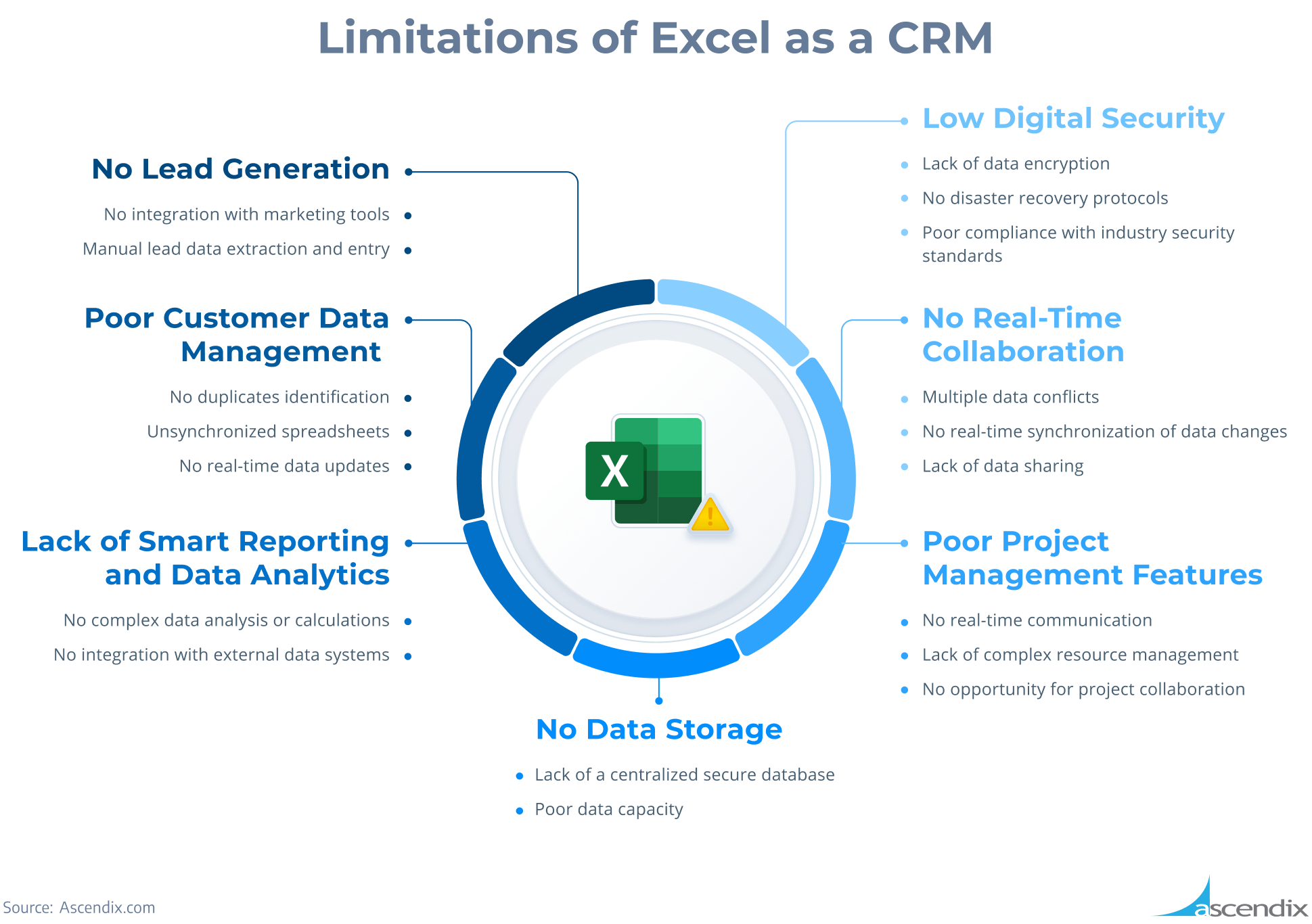
Limitations of Excel as a CRM
Considering the above, Excel can be a decent tool at the sunrise of your business. But as time goes by, customer bases grow, and managing large data volumes leads to errors, so, eventually, 65% of startups switch from Excel to CRM 5 years later on average.
One of our CRE clients relied on Excel matrix and color coding for too long before realizing that capturing, managing and following up with leads turned into a chaotic and overwhelming process. Prior to switching to AscendixRE CRM, our client had heavily invested in lead generation, but by that time, they’d already lost prospects with inefficient Excel management. We’ve integrated AscendixRE with their lead generation sources (LoopNet and CREXi), ensured their leads fell right into the CRM, and streamlined the client communication for brokers who, by that time, had been bombarded with 24/7 correspondence.
Yes, Excel is a cost-efficient solution that can be used as a low-scale CRM, but, as you see from the case study, it will hinder your business growth in the long run. Are there other constraints? Let’s find out.
Excel doesn’t integrate with marketing tools that catch your leads from the website and feed the data on them right into the system. With Excel, users often have to extract the lead data from sources like Linkedin Sales Navigator and manually enter it.
It’s impossible to score or qualify leads, and sales teams lose high-priority prospects.
Once you create CRM in Excel, be prepared that your data might be inaccurate and include duplicates (for instance, you might accidentally add a new lead without knowing they’re already in your system).
Unlike CRM, Excel data volumes will be scattered in multiple ‘unsynchronized’ spreadsheets and lack real-time updates, which worsens with the fact that different users might get different versions of the same spreadsheet.
Sure, both CRM and Excel offer reporting and analytics, but when it comes to complex data analysis, Excel falls short due to being non-intuitive, lacking integration with external data systems, and offering no complex reports and calculations.
Excel can’t be trusted as sensitive data storage since the data is not encrypted, and it does not have disaster recovery protocols. It’s easier to hack your Excel CRM data compared to data kept in a traditional CRM – not only because of the lack of compliance with industry security standards but also because Excel CRM files are often shared by email and other channels.
Excel is not designed as storage for large data volumes. It lacks digital security as we’ve found out and acts more as a tool where small data volumes can be manually entered and analyzed. With too much data being entered, however, come Excel performance issues, and if the data is erased, users can’t restore it in most cases.
Unlike CRM, Excel is notoriously famous for its version control issues and data inconsistency when multiple users try to collaborate simultaneously. In Excel, changes on spreadsheets aren’t synced in real-time, hence data conflicts occur. Additionally, collaborating and sharing data on mobile devices is challenging.
Again, Excel wasn’t built as a project management platform. Sure, you can leave notes and comments to your team members on spreadsheets, but as for real-time communication, you’ll have to use third-party channels.
You can track the project progress on a very basic level, but Excel will still lack sophisticated features like complex resource management or automatic project updates.
‘Can you create a CRM in Excel?’ is a burning question, basically translated as ‘Should I invest all my resources in CRM?’ Well, using the good old Excel as a substitution for CRM is an option in the short run, but once your business expands, you’ll start noticing problems only CRM can solve.

CRM vs Excel Advantages
So, what do you get once you decide to trade Excel for CRM? You can:
Some brokerage CRMs integrate with multiple listing services (MLS) and allow users to access up-to-date property information right from within the platform. Brokers can effortlessly organize, update, and access property data while also receiving real-time notifications on status changes.
For example, AscendixRE has a built-in module for listing management – MarketSpace, which allows brokers easily create and update listings right from the CRM, plus it doubles up as a secure space for deals and collaboration with clients. MarketSpace is available in the xRE Unlimited plan.
AscendixRE is CRM for CRE agents that in addition to CRM functionality has a property listing platform solution. Request a demo.
You no longer need to use spreadsheets with customized formulae or special third-party calculators to track and manage brokerage commissions. With data like commission rates and property prices entered into the system, CRM can automatically perform calculations for you, generate commission reports, and forecast potential earnings.
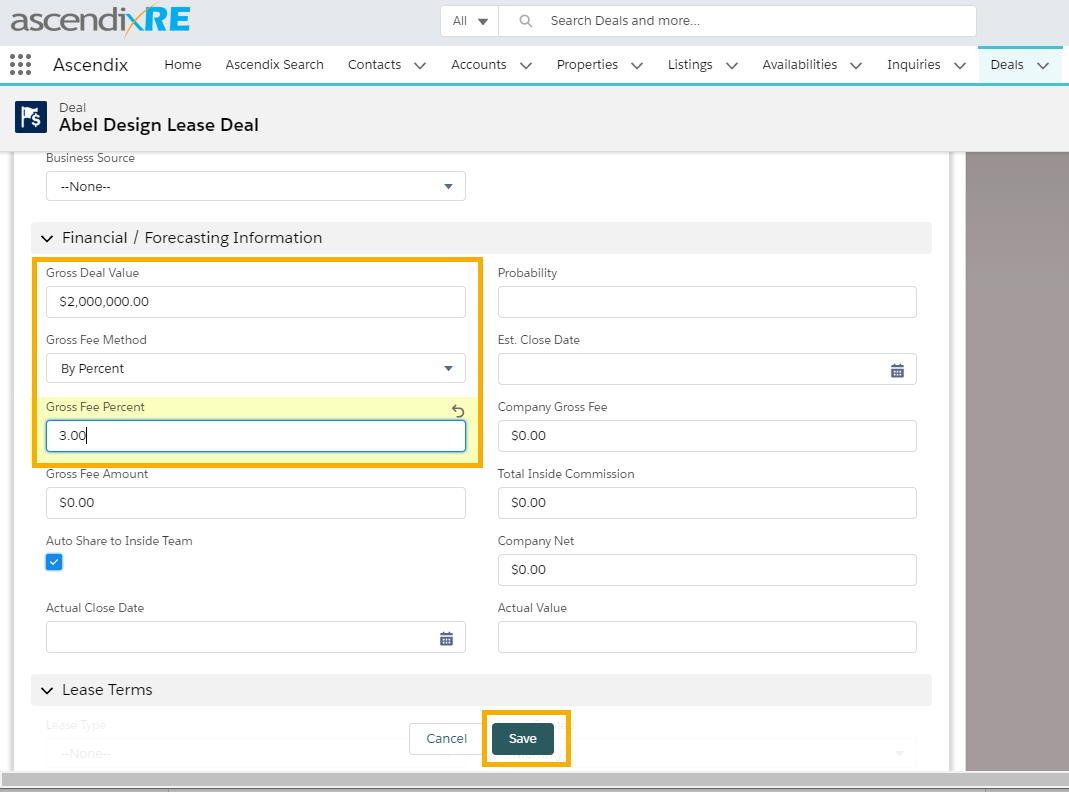
Calculate and Predict Commissions with AscendixRE
More than that, some brokerage-tailored CRMs like AscendixRE can not only calculate and predict commissions earned by a specific broker but can handle intricate commission splits between in-house brokers, third-party referrers, and the brokerage itself. And if you are a part of large corporation where your yearly commission rates grow by the total amount of deals closed, you can benefit from the commission tracking based on a tailored brokerage plans.
Here’s how it could work:
Commission Plan:
First $1 million in sales: Broker gets a 3% commission rate.
Sales beyond $1 million: Commission rate bumps up to 4%.
Now, picture a scenario where the broker hits $1.5 million in sales. The CRM can crunch the numbers using this plan:
For the initial $1 million: Commission = $1 million * 3% = $30,000
For the remaining $500,000 (above $1 million): Commission = $500,000 * 4% = $20,000
Total Commission = $30,000 + $20,000 = $50,000
So, if a broker hits $1 million in sales, their commission rate for the next million would increase from 3% to 4%, resulting in a higher commission amount.
We have included this functionality in our convenient Commission Split Plans & Invoicing Bundle, catering to the specific needs of larger organizations. Proceed to a demo here.
Brokers can customize stages in a visualized deal pipeline, getting a full visibility into the details like deal value, client and property data, and associated contacts. Users can track their interactions with clients and get follow-up reminders sent by the system. Meanwhile, tracking your deal status and progress is easier with the drag-and-drop interface as it is shown in the AscendixRE screenshot example below.
With automated follow-up reminders, sales professionals can touchpoint with their clients with greater efficiency, ensuring no opportunity is lost. And as we’ve mentioned, all data on client requests, interactions, and transactions gets stored in the CRM and can be used for future data analysis.

Deal Pipeline Management with AscendixRE
As we’ve already mentioned, most CRMs integrate with marketing automation tools and help you capture prospects from lead-generation sources. With CRM, you can track and analyze website visits, lead behavior, and later create personalized marketing campaigns. And when integrated with such tools, a CRM helps users schedule and publish social media content.
For instance, AscendixRE, a brokerage CRM, is a perfect example of users leveraging the integration of CRM and marketing automation tools like Mailchimp. Due to our recent integration, users don’t have to switch from AscendixRE to Mailchimp to create emails and send them as well as separately update existing email templates with new or updated property data.
All users have to do is define the right email audience based on specific criteria with a reporting function in AscendixRE, select the recipients with Mailchimp (all without leaving AscendixRE), add them to the email, and send it. Pretty simple, right?
This is where CRM wins in CRM vs Spreadsheets competition. Sometimes, brochure and flyer generation is possible when CRM is integrated with separate brochure generation tools. Other times, such a feature comes as an add-on functionality, often powered by AI for brokers.
In AscendixRE, for instance, a brochure generation module comes out of the box, so there is no need to build add-on APIs for integration with special brochure generation apps.
Regardless of the case, users can automatically populate pre-built forms, customize templates, and send them to clients as a part of the sales process.
With Composer you can quickly build your custom template and generate a professionally looking report without design firm help.
As a rule of thumb, both CRM and Excel don’t come with a stacking plan generation feature. Most often, a user will have to opt for 2D/3D floor plan software like AutoCAD or Cedreo.
If you’re lucky to find a CRM like AscendixRE, with a stacking plan generation module, now you can empower your property management or any other real estate activity like property appraisals with visualized property layouts and simplified lease tracking.
Stacking plan generation in AscendixRE comes as a built-in module. To visualize the space in AscendixRE, all you need to do is fill in the ‘Floors Above Ground’ and the ‘Average Floor Size’ graphs and later add details like Leases and Tenants in the building as well as Vacant spaces (check the full stacking plan generation guide here).
With a few more clicks, you’ll create a stacking plan with color-coded leases and later will be able to export it in Excel or PDF and send it to your potential clients.
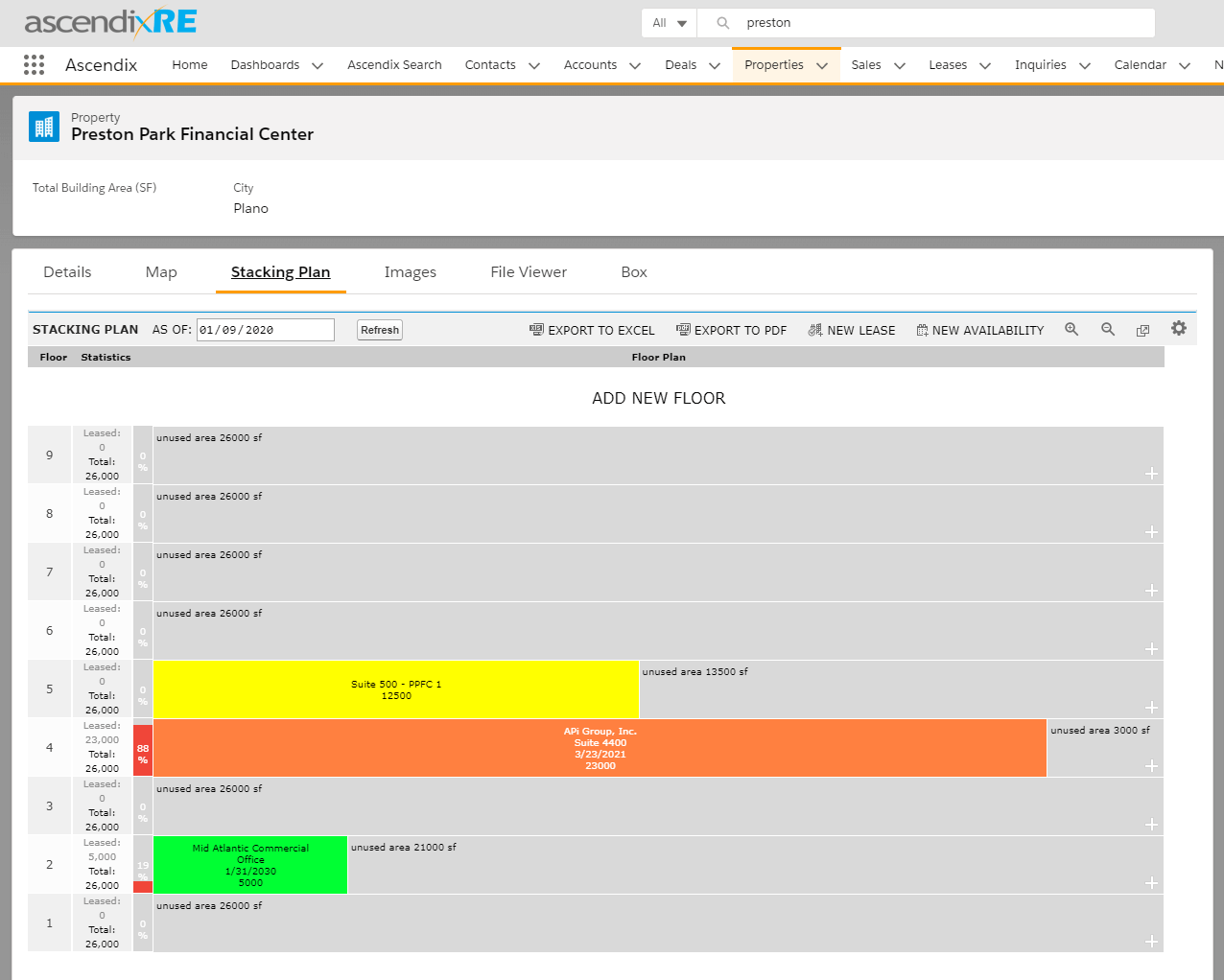
Stacking Plan Example in AscendixRE
A standard CRM acts as a centralized database with up-to-date data that everyone in a team can access. CRM integrates with email, allows users to communicate in chats, store documents, share files, and leave notes.
For instance, with AscendixRE, brokers can track their tasks, presenting them in Table, Kanban, and Split View and drag-and-dropping them according to the statuses like Not Started, In Progress, Completed, Waiting for Someone, and Deferred. Along with that, brokers can create recurring series and set reminders, so, in the end, no lead is left unnoticed.

Task Management with AscendixRE
As you might have already noted, third-party integration is the blood and bone of any CRM. And this is where Excel CRM can’t hold a candle to a real CRM. While Excel integrates with other Microsoft products, it doesn’t integrate with tools like floor management software or marketing automation tools, all of them so vital to broker’s performance.
The third-party tools CRM integrates with are as follows:
As your workflow becomes more complex, your CRM can be customized to accommodate new needs and automate new tasks. For instance, you can add AI-powered assistants and chatbots once your customer base grows and the response times get exceedingly longer. In other words, you can build more functionality blocks on top of CRM and integrate with more third-party systems. Can you do it with Excel? No.
Sure, you can create CRM in Excel and leverage basic reporting and analytics. But the main difference between CRM and Excel is that the former was built for dealing with large data volumes, hence providing complex reports and robust analytics. For instance, with the data updated in real-time, CRM can perform dynamic brokerage performance reporting, ensuring accurate results.
Another example is predictive analytics, which comes as an add-on to a standard CRM and helps users get a profound understanding of the company’s historical data. And as you might’ve guessed, Excel doesn’t offer such functionality.
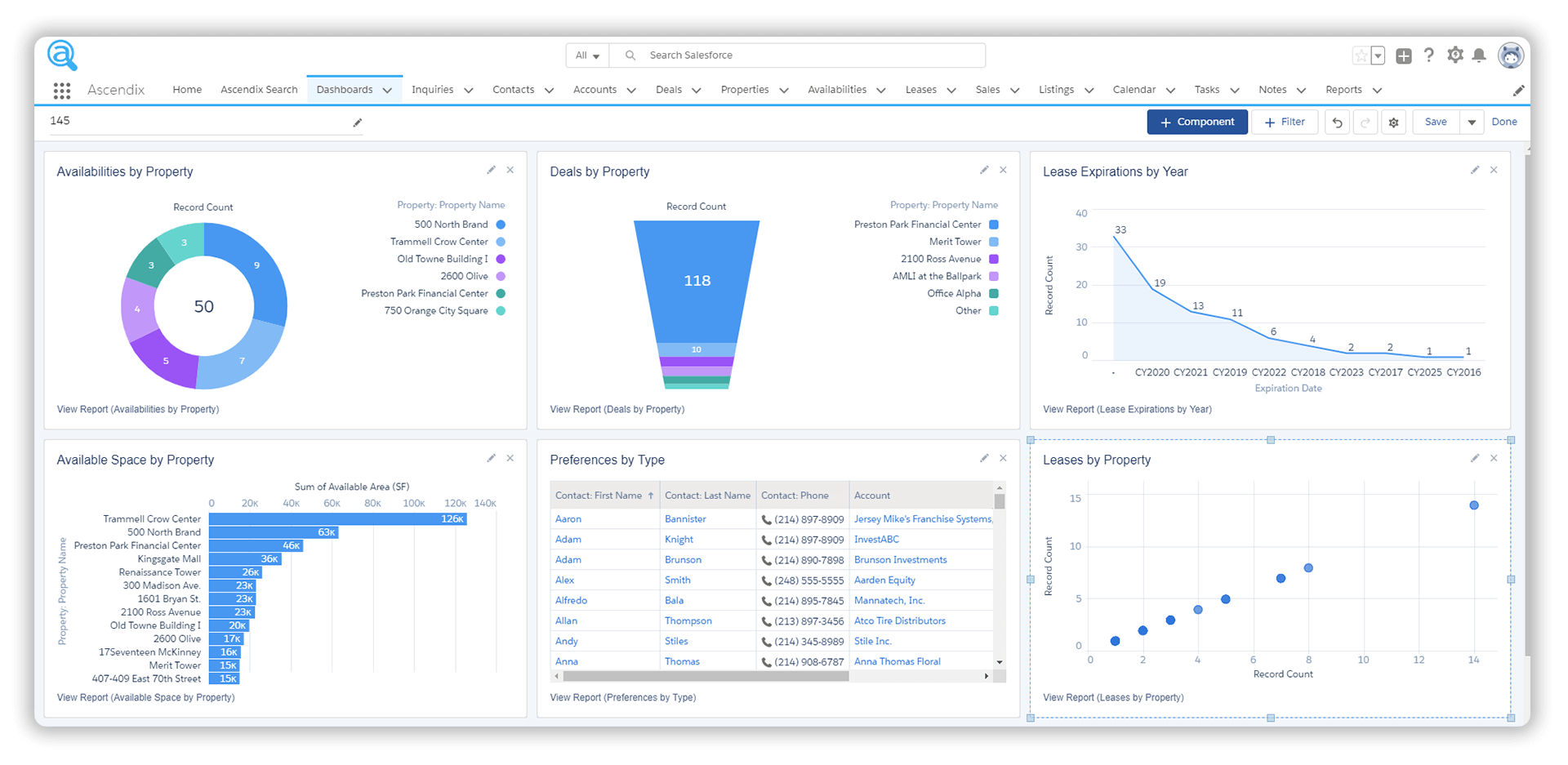
Reports and Dashboards in AscendixRE
CRM developers take digital security seriously. Not only do they offer data security software updates, but they also ensure their safety measures like data encryption comply with industry standards such as General Data Protection Regulations (GDPR).
And yes, building CRM in Excel is an unsound idea, since only a professional non-Excel CRM can offer disaster recovery protocols, regular backups, and secure APIs and integrations.
Built on top of Salesforce, AscendixRE is a brokerage CRM, perfect for tenant and landlord representatives, investment sales, commercial mortgage banking brokers, land brokers, and property managers. AscendixRE has been selected as a great alternative to Costar Brokerage Apps, which are not going to be supported anymore, according to CoStar’s ranking.
So, what do you get with AscendixRE as a real estate professional?
AscendixRE is a secure and cloud-based solution that takes care of your brokerage workflows and communication with clients and saves you from the burden of learning Excel formulae and macros. To experience all the software capabilities, please schedule a demo and check out how AscendixRE can be the right solution for your business.
Try AscendixRE. Schedule a free demo session today to learn more about AscendixRE CRM features.
We are a Texas-based company devoted to helping real estate companies empower their businesses with the latest technology.
Why Ascendix?
How can we help you?
Thousands of brokers are already benefiting from CRM and winning the hearts of loyal clients. So, why not join real estate innovation? Book a free CRM consulting call with Ascendix and learn how we can help you.
Excel vs CRM limitations are zero lead generation, non-centralized data management, poor reporting and data analytics, low digital security, no data storage, lack of real-time collaboration, and low project management functionality.
Using Excel as a CRM in the short run is a good idea for CRE startups, businesses with small customer bases, uncomplicated sales funnels, and low data volumes.
Tania is a fan of technologies and an expert in writing about them. In her content, she shares insights into new trends and proptech solutions in real estate that can help your business thrive while keeping your customers content (pun intended).
AscendixRE is a great CRM for brokers of all sizes. Try AscendixRE CRM right now. We'll help you to set up everything and upload your data. No obligations.